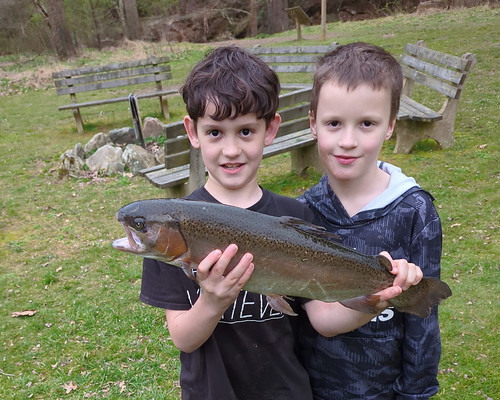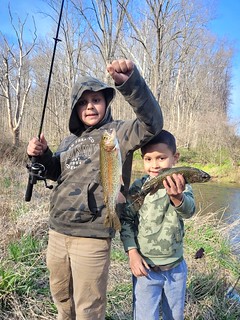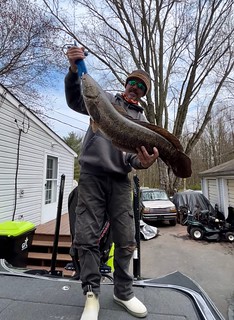Maryland Fishing Report – April 5

Christian Fritz caught this large rainbow trout and hams it up with his brother Everett for the camera held by a proud father. Photo by Craig Fritz
It seems spring has finally arrived with some very welcome weather. Now is a great time to get outdoors, and fishing together with family and especially children is a wonderful activity. The spring trout stocking program continues throughout Maryland. This presents an excellent time for our younger anglers where they can achieve success while fishing.
Forecast Summary: April 5 – April 11:
Recent warm temperatures have quickly warmed Maryland Bay waters for gamefish including striped bass, shad and herring which are spawning or preparing to spawn in the next couple of weeks. Main Bay surface water temperatures have risen to the low to mid 50s. River temperatures have also climbed into the low to mid 50s. Smaller streams and downwind areas on a sunny day will warm faster and often hold water temperatures in the mid to upper 50s. Low salinity areas in this temperature range are prime locations for spawning perch as they move up from their wintering areas in the downstream portion of rivers.
Bay salinities are about normal. Expect average clarity for most Maryland portions of the Bay and rivers, however, expect temporary reduced water clarity from algal blooms on the Potomac near Colonial Beach, Gunpowder, Bush, Back rivers as well as the main bay near Tolchester. To see the latest water clarity conditions, check Eyes on the Bay Satellite Maps.
Expect average flows for most Maryland rivers and streams. There will be above average tidal currents all week as a result of the upcoming full moon April 6.
As always, the best fishing areas could be further refined by intersecting them with underwater points, hard bottom, drop-offs, and large schools of baitfish.
For more detailed and up-to-date fishing conditions in your area of the Bay, be sure to check out Eyes on the Bay’s Click Before You Cast.
The area around the lower Susquehanna River and Flats is now closed to catch-and-release fishing for striped bass until May 16. At that time anglers will be allowed to keep one striped bass that measures between 19 inches and 26 inches. In the meantime, anglers will be focusing on fishing for a mix of channel, flathead, and blue catfish at the Conowingo Dam pool and the lower Susquehanna River. Hickory shad and American shad are arriving and staging in the river and dam pool and provide fun catch-and-release fishing on light tackle. Small spoons, shad darts and bright colored sinking flies will attract the attention of the shad.
Channel and blue catfish are abundant in the upper Bay and tidal rivers this month, and are very active in the river channels. Cut bait is a popular choice for bait but items such as chicken liver and scented baits can work well. When cleaned to remove all the red meat and silver skin, the catfish filets can be quite tasty.
White perch are still being caught in the tidal rivers this week; often they can be found moving down the rivers from the spawning areas. Using pieces of bloodworm on a bottom rig in the channel waters is a great way to catch them. Now that spawning is about over for most of them, they will be headed for their summer habitat areas. The exception will be the lower Susquehanna River, due to the cold water coming from the dam, the spawning activity there often does not occur till later this month.
Now that the striped bass catch-and-release season is over and the trophy season does not open in the middle Bay until May 1, anglers have two choices – work on their boat or go fishing for catfish and white perch in the tidal rivers. There are plenty of channel catfish to be found in all the tidal rivers, along with a sprinkling of blue catfish. The Choptank River holds the greatest number of blue catfish, and they can be found in the Dover Bridge area. Fresh cut menhaden is the premier bait but cut gizzard shad, white perch, and chicken liver all work well. Circle hooks are recommended if fishing with bait, to protect any spawning striped bass that are caught by accident.
Striped bass have been spawning in the Choptank since late March, and biologists tell us the largest females often spawn early. Current water temperatures in the upper Choptank are about 55 degrees, which is getting close to the ideal spawning temperatures of 56 to 58 degrees. The larger females of 50-plus pounds or more can release more than 4 million eggs, while smaller females of 5 pounds or so will release about 450,000 eggs.
Male striped bass fertilize the eggs as they are released, which occurs when the male striped bass bump the females to release eggs. The eggs are small, about 1.35 millimeters and swelling to almost 2 millimeters. They harden in the water and will float along in the current. The eggs will go through various stages of development until about 13 weeks when they look like miniature striped bass. In their early stages, zooplankton are an important food source and at 13 weeks they begin to feed on small marine worms, shrimp, and similar small items. Protecting this spawn is why Maryland closes its striped bass fishery this time of year, and it is essential we respect this closure.
White perch are beginning to move downriver from the spawning areas and they can be intercepted by fishing the river channels with bottom rigs baited with pieces of bloodworm. As April progresses, they will travel to their typical summer habitats at the lower sections of the tidal rivers and creeks. They should reach these areas by the first week of May.
Striped bass are off the table in the lower Bay until May 1, so many anglers are focusing their attention on fishing the tidal rivers for catfish and white perch. The tidal Potomac River from the Wilson Bridge south to the Route 301 Bridge is full of blue catfish. They can be caught by anchoring up on a main channel edge and fishing with cut bait on the bottom. The Patuxent River also holds a lot of blue catfish from the Route 231 Bridge in Benedict to Jug Bay. The Nanticoke River near the mouth of Marshyhope Creek and Sharpstown also holds large populations of blue catfish. The Sharpstown public park offers a great place to fish from the shore.
Striped bass are holding in the spawning reaches of the Potomac, Patuxent, and Nanticoke this week and are beginning to spawn. It is predicted that the bulk of the spawn will occur starting this coming weekend until the end of the second week of April.
Hickory shad are moving up the tidal Potomac and Patuxent rivers this week and have reached Fletchers Landing, a popular area for catch-and-release fishing. American shad can also be found at this section of the tidal Potomac. Anglers are reminded if they fish the Potomac above the Maryland line, they will need a District of Columbia recreational fishing license.

Hunter and Bryson Latchman had a great time fishing for trout and showing off their catch. Photo by Bedesh Latchman
Trout anglers are enjoying the second week of the traditional season in the put-and-take waters. The stocking of trout will continue every week and the areas will be posted on the Department of Natural Resources website each day after the stockings take place.
Trout fishing in the put-and-take areas and the designated youth fishing waters is a great opportunity for our younger anglers to experience success. Maryland also offers youth fishing events known as fishing rodeos to get our younger anglers into the action. They are usually held at community ponds and parks where there is easy access, plenty of parking, and often prizes for categories of the most fish, largest fish, etc. The Department of Natural Resources lists all fishing rodeos on our website. All rodeos that take place in Maryland State Parks also are posted online.
The walleye brood collection was successfully completed by biologists on the upper Potomac River during March. A total of 11 females and 22 males were transported to the department’s Joseph Manning Hatchery for use in juvenile walleye production. The largest walleye was 26 inches. Roughly 30% of the walleye collected were within the 15–20-inch slot limit. Walleye greater than 20 inches in length comprised 45 percent of the sample. Anglers have reported catching spent females below Dam 4, indicating that spawning has taken place in the river.
April is an important month for largemouth bass and the anglers who fish for them. Largemouth bass are in their pre-spawn mode of behavior; the female bass are feeding aggressively to build up body stores for spawning, which occurs soon. They typically will be holding in transition waters that are deeper than the shallow spawning areas. Male largemouths are preparing spawning beds in the shallows and will be found there holding near the beds they have prepared.
Fishing for crappie remains good this week, as they are schooled up near any kind of structure they can find in relatively deep waters. Fallen treetops, sunken brush, sunken wood, marina docks, and bridge piers are all good places to fish. Placing a small marabou jig or small minnow under a slip bobber is a great way to fish for them.
Grass beds are quickly filling in, but most waters are open enough that chain pickerel are holding near sunken wood. Warmer water temperatures are causing northern snakeheads to become more active. The tidal Potomac and creeks feeding into it are an excellent place to look for them. The Dorchester County creeks as well as the Nanticoke River tributaries, the Patuxent, and the upper sections of tidal rivers throughout the Bay all have populations of northern snakeheads. Casting white paddletails and drifting large minnows under a bobber are two excellent ways to currently fish for them.
Anglers are enjoying fun fishing for striped bass around the inlet rocks and the piers of the Route 50, Route 90, and Route 611 bridges this week. Casting soft plastic jigs and working them close to the bottom has been working well for what is mostly a catch-and-release fishery, as only a few fish meet or exceed the 28-inch minimum.
Tautog are being caught in the inlet and Route 50 Bridge area on sand fleas. Most baits are being fished close to rocks, bridge piers, and bulkheads. Most of the tautog are measuring a little short of the required 16 inches. Flounder are becoming a more common catch in the back bay channels this week. Water clarity is key and with boat traffic at a minimum drifting in the channels is a pleasant way to fish.
The captains taking anglers out to the wreck and reef sites have been treating them to some outstanding catches. Many of the for-hire boats are boasting double-digit weights for tautog coming over the rails.
“There is value in any experience that exercises those ethical restraints collectively called sportsmanship.” — Aldo Leopold
Maryland Fishing Report is written and compiled by Keith Lockwood, fisheries biologist with the Maryland Department of Natural Resources.
Click Before You Cast is written by Tidewater Ecosystem Assessment Director Tom Parham.
This report is now available on your Amazon Echo device — just ask Alexa to “open Maryland Fishing Report.”

